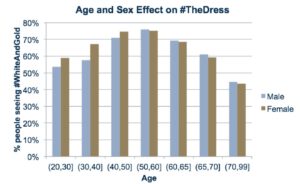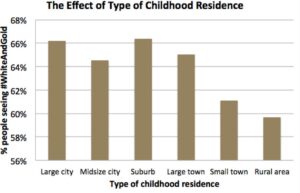Yeah, it’s that damn dress again.
If you haven’t been online recently you might have missed it, otherwise you know exactly which striped dress we’re talking about. You know, the one that
You know, the one that melted the Internet.
So why are we bringing this whole thing up again? It turns out that what colors you see in those stripes has a lot to do with how old you are and where you grew up, according to new research done by scientists here at 23andMe.
The huge amount of interest in this weird debate offered researchers at 23andMe a chance for an instant genetics experiment. A lot of people looked at that dress, but some people see white and gold, while others see blue and black.
Why is that? Do our genes play an obvious role in the difference of how we perceive color?
That’s what we wanted to know.

23andMe computational biologist Fah Sathirapongsasuti, PhD
Buzzfeed and Wired both wrote about how our brains interpret light based on visual signals. The differences we see may be how our brains filter out different parts of the color spectrum. Alternatively, the differing density of our rod and cone cells or the cornea color could make some people see the world a bit more yellow or blue. The question is whether there is a clear biological reason for the difference.
The short answer is that 23andMe researchers didn’t find any obvious genetic association for that difference. We’ll get to some of what we found a little later. First off it’s important to note that 23andMe regularly surveys customers asking them a slew of questions about their health, their traits and even seemingly odd queries about whether they can curl their tongues or do a somersault. When we combine all this information with their genetic information it feeds into a novel research platform that allows our scientists to learn more about the genetic influence on disease, traits and human behavior.
So a few days ago we asked some of our customers who have consented to research about what colors they saw when they looked at that dress. About 25,000 people responded, and this is some of what our researchers learned.
For one, there was no clear genetic association with seeing either a blue and black dress versus seeing a white and gold one, according to Fah Sathirapongsasuti, PhD, a computational biologist here at 23andMe. That doesn’t mean there is no association, it just means that we didn’t find one that met our threshold for a strong association.
We did see a small effect size for a genetic variant in the gene ANO6. While this may or may not be significant, it’s interesting because ANO6 is in the anoctamins gene family, which includes the gene ANO2. The gene ANO2 is involved in light perception, so this might be something that warrants further study. But as we said, the association we saw did not show a big effect. Others who’ve looked at the possible genetic influence of how people perceive the color of the dress also did not find a strong genetic association, finding, for instance, that identical twins also reported seeing different colors.
While we first looked at genetic associations with different color perceptions, we went on to see if there were other associations related to different phenotypes. The strongest association we found was with age. Our researchers found that the effect of age comes in two phases – for people up to 60 years old and for those who are over 60. According to our data the proportion of those who see white and gold increased up until the age of 60, but after 60 the proportion of those who see white and gold starts to decrease. We don’t know why that might be, according to Fah. Retinal cells responsible for color perception become less sensitive as we age, which could account for some of what our data show, but it doesn’t explain the different trends, he said.
We don’t know why that might be, according to Fah. Retinal cells responsible for color perception become less sensitive as we age, which could account for some of what our data show, but it doesn’t explain the different trends, he said.
According to 23andMe’s data at around 20 years of age, customers were split evenly between those who saw a white and gold dress versus those who saw blue and black. But as customers get older the proportion of those who see white and gold increased up until the age of 60 when more than three quarters of those surveyed said they see a white and gold striped dress instead of blue and black one.
This effect is more dramatic in men where the proportion of men seeing white and gold increases by almost 15% around the age of 40. Then, according to our data, after 60 years of age, the percentage of those who see a white and gold dress decreases at a steady rate. People over the age of 70 is the only group that see more blue and black than white and gold. Women, who were between the ages of 20 and 50, were also slightly more likely to see white and gold. Our researchers also looked at whether other eye conditions – age related macular degeneration, cataracts and red-green color blindness – clearly influenced how color was perceived. Customers with cataracts were about 50 percent more likely to see black and blue instead of white and gold. Those who are color-blind were more likely to see white and gold, and there was not a strong effect with macular degeneration.
The power of 23andMe research platform is that it allows scientists to look across all phenotypes and genotypes we record to find even unexpected associations. For instance, dress color perception appears to be influenced by the type of place you lived in as a child. Fah found that those who grew up in more urban areas saw white and gold at higher proportions than those who grew up in more rural areas.
While results like these are interesting and could fuel multiple follow-on inquiries, this little experiment with the dress is interesting in another way. It’s instructive because it illustrates the complex interaction between both our genetics and environment.